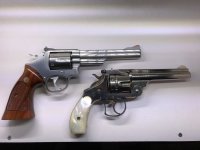Here are two Smith & Wesson double action revolvers, one dating from about 1886 and the other just about exactly 100 years later.
The first one is the 44 Double Action, originally called “New Model Navy No. 3”. It is the result of a design requested by the Russian navy in 1872, the first double action design S&W had attempted. The offer to produce these at $14.45 each for the Russians never went anywhere, and the 44-caliber gun was shelved until 1880. In the meantime, other makers, like Colt and Forehand & Wadsworth had introduced a double action revolver by 1877, and S&W was noticing a decline in demand for their single-action top break revolvers. By February of 1880 S&W had a 38-caliber double action revolver on the market. This would be followed by a 32-caliber model in May of 1880, and the 44- caliber revolver began in 1881.

The design of the 44 double action is based on the no. 3 frame, the same as the New Model No. 3 single actions – in fact, the barrels are interchangeable. Although the 44-caliber revolver was the last to be brought to market, it had been the first to be designed, and would continue to be called “First Model”. The lock work of this model is identical to the 32 and 38 caliber double actions, and consists of a typical, “push-pull” arrangement between the hammer and trigger, where, in single action, the front sear engages the hammer and pulls the hand up, and in double action the trigger pushes the hand and hammer up. A pivoting rear sear under the hammer holds the hammer cocked in single action and is released by the trigger pushing up on it when the trigger is pulled. This design was used by early solid frame Webleys, Tranters and Adams double actions, as well as Iver Johnson, F&W and Harrington & Richardson. Colt used an entirely different and unique design in their double action revolvers at that time.

I am not sure at which point S&W changed their design to the spring-loaded front sear and rigid rear (single action) sear they use in their current revolver design, but I suspect it began with the solid frame “hand ejectors”. The example shown here is a NIB K-frame Model 66 Combat Magnum, the lock work shown is that of a Model 686. Except for the hammer block, this design has changed little since the late 19th century, and was common on Webley Bulldogs, Chamelot & Delvigne, Nagant, Belgian “British Bulldogs”, and a variety of American double actions as well.


Looking at the two guns side-by-side, apart in age by almost exactly 100 years, it is difficult to say which is the old and which is the new. Smith & Wesson abandoned the top-break design in 1898, however their early large-frame revolvers can measure up in quality and accuracy to any modern revolver to this day.

The first one is the 44 Double Action, originally called “New Model Navy No. 3”. It is the result of a design requested by the Russian navy in 1872, the first double action design S&W had attempted. The offer to produce these at $14.45 each for the Russians never went anywhere, and the 44-caliber gun was shelved until 1880. In the meantime, other makers, like Colt and Forehand & Wadsworth had introduced a double action revolver by 1877, and S&W was noticing a decline in demand for their single-action top break revolvers. By February of 1880 S&W had a 38-caliber double action revolver on the market. This would be followed by a 32-caliber model in May of 1880, and the 44- caliber revolver began in 1881.
The design of the 44 double action is based on the no. 3 frame, the same as the New Model No. 3 single actions – in fact, the barrels are interchangeable. Although the 44-caliber revolver was the last to be brought to market, it had been the first to be designed, and would continue to be called “First Model”. The lock work of this model is identical to the 32 and 38 caliber double actions, and consists of a typical, “push-pull” arrangement between the hammer and trigger, where, in single action, the front sear engages the hammer and pulls the hand up, and in double action the trigger pushes the hand and hammer up. A pivoting rear sear under the hammer holds the hammer cocked in single action and is released by the trigger pushing up on it when the trigger is pulled. This design was used by early solid frame Webleys, Tranters and Adams double actions, as well as Iver Johnson, F&W and Harrington & Richardson. Colt used an entirely different and unique design in their double action revolvers at that time.
I am not sure at which point S&W changed their design to the spring-loaded front sear and rigid rear (single action) sear they use in their current revolver design, but I suspect it began with the solid frame “hand ejectors”. The example shown here is a NIB K-frame Model 66 Combat Magnum, the lock work shown is that of a Model 686. Except for the hammer block, this design has changed little since the late 19th century, and was common on Webley Bulldogs, Chamelot & Delvigne, Nagant, Belgian “British Bulldogs”, and a variety of American double actions as well.
Looking at the two guns side-by-side, apart in age by almost exactly 100 years, it is difficult to say which is the old and which is the new. Smith & Wesson abandoned the top-break design in 1898, however their early large-frame revolvers can measure up in quality and accuracy to any modern revolver to this day.










































































